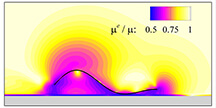Swimming bacteria, sperm increase speed through 'corridors' of low viscosity fluid
December 8, 2015
 |
|
Research into the "shear-thinning" behavior of surrounding fluids on swimming bacteria and spermatozoa has revealed that their beating flagella create corridors of less-viscous fluid, allowing the tiny swimmers to increase their speed while consuming less energy. Data visualized in this color-coded graphic show low-viscosity regions in blue, surrounded by higher-viscosity fluid. (Purdue University image/Gaojin Li and Arezoo Ardekani) |
WEST LAFAYETTE, Ind. – New research findings are yielding insights into the physics behind the swimming behavior of bacteria and spermatozoa that could lead to a better understanding of the mechanisms affecting fertility and formation of bacterial biofilms that foul everything from implantable medical devices to industrial pipes.
Swimming bacteria and spermatozoa use whip-like flagella to propel themselves. The findings show the tiny swimmers are able to increase their speed while consuming less energy because of the "shear-thinning" behavior of their surrounding fluid: Their beating flagella create corridors of less-viscous fluid.
"The fluid becomes less viscous very close to the swimmer," said Arezoo Ardekani, an assistant professor in Purdue University's School of Mechanical Engineering. "So basically there are corridors of low-viscosity fluid that the swimmers are moving inside, allowing them to go faster and also requiring less energy to swim. These results are helpful in better understanding the effects of complex fluids on the locomotion of microorganisms."
The researchers used mathematical modeling to study the physics behind the swimming behavior. Findings are detailed in a paper published in December in the Journal of Fluid Mechanics. The paper was authored by doctoral student Gaojin Li and Ardekani.
Bacteria secrete a mucus-like "extracellular polymeric substance," and spermatozoa swim in a mucous layer covering the female reproductive track. Both the extracellular substance and the mucous layer are shear-thinning "viscoelastic" fluids, meaning they are jelly-like and try to retain their original shape. Findings showed the motion of the flagella shears this complex fluid, causing it to thin in the area immediately surrounding the swimmer.
Understanding these mechanisms could help to eventually derive ways to prevent biofilm formation without applying chemicals. Costs associated with biofilms affecting implantable medical devices and various types of industrial equipment amount to billions of dollars annually. Attacking the biofilms using antibiotics and toxic chemicals has drawbacks including the evolution of antibiotic-resistant strains, which might be alleviated by finding ways to hinder bacterial adhesion without killing the bacteria.
The findings also could be useful in research to better understand the mechanisms behind fertility. "Because fertility is related to motility of sperm, it is important to know how fast or slow they go depending on the property of their surrounding fluid," Ardekani said.
The complex fluids contain biological polymers and suspended particles that make their behavior difficult to quantify, and they are said to be "non-Newtonian."
"This means when you apply a force and look at the displacement there is not a linear relationship between force and displacement," she said.
The researchers provided a "scaling law" that others can use to model and study the swimming microorganisms under various conditions.
The work has been supported by the National Science Foundation and the Indiana Clinical and Translational Sciences Institute Collaboration in Biomedical/Translational Research Pilot Program from the National Institutes of Health, the National Center for Advancing Translational Sciences, and a Clinical and Translational Sciences Award.
Writer: Emil Venere, 765-494-4709, venere@purdue.edu
Source: Arezoo Ardekani, ardekani@purdue.edu
Note to Journalists: A copy of the research paper is available from Emil Venere, Purdue News Service, at 765-494-4709, venere@purdue.edu.
ABSTRACT
Undulatory swimming in non-Newtonian fluids
Gaojin Li1 and Arezoo M. Ardekani1,†
1School of Mechanical Engineering, Purdue University
We numerically investigate the effects of non-Newtonian fluid properties, including shear thinning and elasticity, on the locomotion of Taylor's swimming sheet with arbitrary amplitude. Our results show that elasticity hinders the swimming speed, but a shear-thinning viscosity in the absence of elasticity enhances the speed. The combination of the two effects, modeled using a Giesekus constitutive equation, hinders the swimming speed. We find that the swimming speed of an infinitely long waving sheet in an inelastic shear-thinning fluid has a maximum, whose value depends on the sheet undulation amplitude and the fluid rheological properties. The power consumption, on the other hand, follows a universal scaling law.

